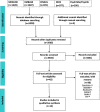Framing the process in the implementation of care for people with generalized anxiety disorder in primary care: a qualitative evidence synthesis
- PMID: 33218311
- PMCID: PMC7678131
- DOI: 10.1186/s12875-020-01307-6
Framing the process in the implementation of care for people with generalized anxiety disorder in primary care: a qualitative evidence synthesis
Abstract
Background: Generalized anxiety disorder (GAD) is one of the most common mental disorders in primary care (PC). GAD has low remission and high relapse rates over long follow-up periods. Qualitative evidence was synthesized to understand the implementation of care and treatment options for people with GAD in PC.
Methods: Research published from 2008 to September 2020 was searched in five databases (MEDLINE, EMBASE, CINAHL, WOS and PsycArticles). Studies that used qualitative methods for data collection and analysis to investigate the implementation of care and treatment options for people with GAD in PC and outpatient settings were included. Non-qualitative studies, mixed methods studies that did not separately report qualitative findings and studies in languages other than English or Spanish were excluded. We used the Confidence in the Evidence from Reviews of Qualitative Research (CERQual) framework to assess the overall confidence in the findings.
Results: The results with a moderate level of confidence showed that the trajectory of care for people with GAD in PC and outpatient settings is long and fluctuates over time, involving multiple difficulties in accessing and maintaining initial treatment or successive treatment options. In addition, there are wide variations in the preferences for and acceptability of different treatment options. The results with a high level of confidence indicated that more information on GAD and its treatment options is needed for PC practitioners, GAD patients and their carers. The results with a low level of confidence suggested that patients use antidepressants for longer than recommended and that the interruption of treatment is not usually planned.
Conclusions: Initial resistance to new treatments among people with GAD can make access and adherence to treatment difficult. Improving care may require patients to be informed of possible trajectories in stepped care pathways before the initiation of treatment so they are aware that they may need to try a number of options until the most effective treatment for them is found. Increased awareness of and information materials on GAD may facilitate both appropriate diagnosis and long-term care.
Keywords: Experiences and Patient Preferences; Generalized Anxiety Disorder; Primary Care; Qualitative Evidence Synthesis.
Conflict of interest statement
The authors declare that they have no competing interests.
Figures
Similar articles
-
Right care, first time: a highly personalised and measurement-based care model to manage youth mental health.Med J Aust. 2019 Nov;211 Suppl 9:S3-S46. doi: 10.5694/mja2.50383. Med J Aust. 2019. PMID: 31679171
-
Comprehensive review of generalized anxiety disorder in primary care in Europe.Curr Med Res Opin. 2013 Apr;29(4):355-67. doi: 10.1185/03007995.2013.770731. Epub 2013 Feb 18. Curr Med Res Opin. 2013. PMID: 23356728 Review.
-
Systematic reviews of the effectiveness of day care for people with severe mental disorders: (1) acute day hospital versus admission; (2) vocational rehabilitation; (3) day hospital versus outpatient care.Health Technol Assess. 2001;5(21):1-75. doi: 10.3310/hta5210. Health Technol Assess. 2001. PMID: 11532238 Review.
-
Interventions for adults with a history of complex traumatic events: the INCiTE mixed-methods systematic review.Health Technol Assess. 2020 Sep;24(43):1-312. doi: 10.3310/hta24430. Health Technol Assess. 2020. PMID: 32924926 Free PMC article.
-
Promoting and supporting self-management for adults living in the community with physical chronic illness: A systematic review of the effectiveness and meaningfulness of the patient-practitioner encounter.JBI Libr Syst Rev. 2009;7(13):492-582. doi: 10.11124/01938924-200907130-00001. JBI Libr Syst Rev. 2009. PMID: 27819974
Cited by
-
Demand management processes to improve access to cognitive-behavioral therapies for anxiety disorders: a grounded theory study.Front Health Serv. 2024 Jan 11;3:1266987. doi: 10.3389/frhs.2023.1266987. eCollection 2023. Front Health Serv. 2024. PMID: 38274712 Free PMC article.
-
Decision aids linked to the recommendations in clinical practice guidelines: results of the acceptability of a decision aid for patients with generalized anxiety disorder.BMC Med Inform Decis Mak. 2022 Jun 30;22(1):171. doi: 10.1186/s12911-022-01899-2. BMC Med Inform Decis Mak. 2022. PMID: 35773665 Free PMC article.
-
Mapping Evidence and Constructing an Analytic Framework: An Umbrella Review Summarizing Primary Care Family Physicians' Experiences With Clinical Integration.Ann Fam Med. 2025 Jul 28;23(4):350-362. doi: 10.1370/afm.240118. Ann Fam Med. 2025. PMID: 40721330 Free PMC article.
-
Barriers and Facilitating Factors of Adherence to Antidepressant Treatments: An Exploratory Qualitative Study with Patients and Psychiatrists.Int J Environ Res Public Health. 2022 Dec 14;19(24):16788. doi: 10.3390/ijerph192416788. Int J Environ Res Public Health. 2022. PMID: 36554679 Free PMC article.
References
-
- Wittchen HU, Jacobi F, Rehm J, Gustavsson A, Svensson M, Jönsson B, et al. The size and burden of mental disorders and other disorders of the brain in Europe 2010. Eur Neuropsychopharmacol. 2011;21(9):655–679. - PubMed
-
- World Health Organization. Mental health in the workplace [Internet]. WHO. World Health Organization; 2017 [cited 2020 May 22]. Available from: https://www.who.int/mental_health/es/.
-
- Locke AB, Kirst NSC. Diagnosis and management of generalized anxiety disorder and panic disorder in adults. Am Fam Physician. 2015;19(9):617–624. - PubMed
Publication types
MeSH terms
Substances
LinkOut - more resources
Full Text Sources
Medical


